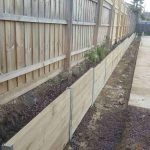Introduction
When it pertains to landscaping and structural integrity, couple of components are as vital as keeping walls. https://tuffstuffretainingwalls.com.au/ They supply stability, boost aesthetics, and prevent soil disintegration. Nevertheless, not all retaining wall installations are created equal. What sets top-tier retaining wall installers apart? It's a question that numerous homeowners consider when preparing their outside jobs. In this post, we'll explore the distinguishing features of elite installers-- including their expertise in products like timber sleeper and concrete sleeper walls, their usage of H beams for included support, and their professional approach to every project.
What Sets Top-Tier Retaining Wall Installers Apart?
Top-tier retaining wall installers stand out due to their exceptional skills, experience, and commitment to quality. Here's what makes them truly special:
Expert Understanding of Materials- The best installers have an extensive understanding of various products-- whether it's timber sleeper walls that use a rustic appeal or concrete sleeper alternatives offering resilience and strength.
- Their designs are carefully planned to ensure that they fit the landscape while sticking to engineering requirements. They think about elements like drain, soil type, and load-bearing capacity.
- These specialists don't simply throw up a wall; they employ sophisticated installation methods that ensure durability and stability.
- Top-tier installers pay attention to details that others may neglect-- everything from the alignment of blocks to the finishing touches that enhance visual appeal.
- They adhere strictly to security policies during installation procedures to protect both employees and property.
- Effective communication with clients guarantees that expectations are satisfied and any concerns are immediately addressed.
- Many premier installers include eco-friendly practices into their work process, guaranteeing minimal ecological impact.
- Providing warranties on work completed displays self-confidence in quality while ensuring clients of ongoing support.
- Their focus is constantly on consumer fulfillment; they aim to exceed customer expectations through every phase of the project.
- Offering maintenance services or advice after installation shows a commitment beyond just getting the task done.
Understanding Different Types of Keeping Walls
Timber Sleeper Walls
Timber sleeper walls have actually gained appeal for their aesthetic appeal and ease of installation. Made from dealt with wood, these walls can be an attractive addition to gardens or outdoor spaces.
- Pros:
- Cons:
Concrete Sleeper Walls
Concrete sleeper walls add a modern-day touch while providing exceptional strength compared to lumber alternatives.
- Pros:
- Cons:
H Beam Reinforcement
H beams play an important function in strengthening maintaining walls, especially for taller structures requiring additional assistance against lateral earth pressure.
- Benefits:
- Enhanced structural integrity Increased resilience over time
Factors Influencing Retaining Wall Costs
Material Choice
The option in between timber sleeper, concrete sleeper, and even stone will substantially impact costs.
Wall Height & & Length
Taller and longer walls require more products, labor, and engineering factors to consider-- hence increasing overall expenses.
Site Conditions
Challenging website conditions such as high slopes or rocky terrain can complicate setup procedures leading to higher expenses due to additional labor requirements.
Local Laws & Permits
Some locations may require specific authorizations before construction starts which can add costs through charges or hold-ups in scheduling work.
Installation Process Explained
Step-by-Step Guide
Initial Consultation: Discussing ideas with clients. Site Assessment: Examining soil conditions. Design Preparation: Developing comprehensive designs. Material Choice: Choosing in between wood sleepers or concrete sleepers based upon needs. Preparation Work: Cleaning the area for foundation laying. Foundation Structure: Building a solid base utilizing H beams if necessary. Wall Building and construction: Setting up the wall following design specifications. Finishing Touches: Including visual appeals such as caps or landscaping around the wall. Final Evaluation: Ensuring everything is up-to-standard before completion.Common Mistakes Made by Do It Yourself Installers
Many homeowners think about setting up maintaining walls themselves however frequently neglect critical elements leading to bad outcomes:
Failure to Plan Properly: Skipping style stages can cause misalignment concerns later down the road.
Incorrect Material Use: Not choosing suitable materials for particular environmental conditions can trigger premature failure.
Lack of Drainage Solutions: Overlooking correct drainage can result in water accumulation causing damage over time.
4. Ignoring Regional Regulations: Not acquiring needed licenses may lead house owners into legal trouble later on down the line!
FAQ Section
Q1: The length of time does a retaining wall last?
A: With appropriate construction using quality materials like concrete sleepers or wood sleepers-- and ideal upkeep-- it can last anywhere from years approximately a lot more than fifty years!
Q2: Do I require an authorization for building a retaining wall?
A: Yes! Most city governments need licenses depending upon height limitations; consult your regional authority before starting any project!
Q3: What's better-- timber or concrete sleepers?
A: It depends upon your requirements! Lumber provides natural charm at lower costs while concrete supplies enhanced resilience however at higher preliminary expenses!


Q4: How deep need to footings be for a maintaining wall?
A: Normally speaking footings need to extend listed below frost lines; generally anywhere in between twelve inches(30 cm)for smaller structures up till twenty-four inches(60 cm)for larger ones!
Q5: Can I develop my own retaining wall?
A: While do it yourself is possible; employing specialists ensures compliance with finest practices which ultimately leads towards higher longevity & fulfillment rates down the line!
Q6: Exist any upkeep ideas I ought to follow?
A: Frequently inspect joint seals & drain areas keeping them clear from particles will assist maintain performance over time!
Conclusion
In conclusion, comprehending what sets top-tier retaining wall installers apart is important for anyone thinking about such tasks on their property! By focusing on knowledge across different products-- from timber sleeper options right through sturdy concrete alternatives-- these specialists highlight quality workmanship together with robust post-installation support! As you launch your journey towards enhancing your outdoor area with perfectly built retaining walls remember-- it settles huge time buying knowledgeable craftsmanship rather cutting corners through cheaper options! With this understanding under your belt you'll be well-equipped making informed decisions moving forward!